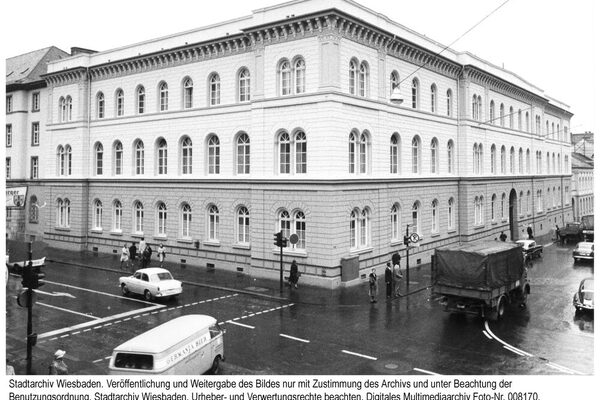Ministerial building (government building)
The former ministerial building on the corner of Luisenstraße and Bahnhofstraße is now home to the Hessian Ministry of Justice. It stands on the former extensive garden grounds of Ernst Freiherr Marschall von Bieberstein, which the government of the Duchy acquired after his death in 1834 in order to erect a new administrative building here. This was initially intended to house the ministerial chancellery, an apartment for the Minister of State and rooms for the ducal treasury. The competition held in 1834 initially failed to produce a result. Finally, in 1838, it was decided to implement the plan by the young Carl Boos. Now, in addition to the uses already mentioned, rooms for the Chamber of Accounts and meeting rooms for the Estates as well as a throne room were to be accommodated.
Construction of the ministerial building lasted from 1838 to 1843, and in the spring of 1844 the Herrenbank and the Assembly of Deputies were able to meet in the building for the first time. Boos designed the historic building, an irregular three-winged complex, entirely in the style of the Florentine Renaissance. Parts of the building, including the Throne Room and the Hall of Estates, painted by Friedrich Wilhelm Pose, fell victim to a fire in 1854 and were redesigned in 1855-57 according to designs by Philipp Hoffmann with decorative paintings in the Pompeian style. The ministerial building only underwent a radical change in 1925/26, when the farm buildings to the east were demolished and a three-winged, stylistically adapted extension was built to the north of the old building and connected to the side wings of the existing building to create a closed four-winged complex. A remnant of the former manor garden can still be seen today in the large inner courtyard.
Until 1866, the ministerial building was used by the ducal administration and was also the residence of the successive ministers Emil August von Dungern, August Karl Friedrich Hergenhahn, Friedrich Gerhard von Wintzingerode and August Ludwig zu Sayn-Wittgenstein. With the annexation of Nassau, the Prussian civil commissioner Gustav von Diest moved into the building. When Wiesbaden became the seat of the Prussian government president, the ministerial building was also used as the government headquarters.
After the First World War, public life was dominated by the turmoil of the occupation and then the arbitrary rule of the National Socialists. In 1945, the building, which had remained intact, passed into the hands of the Americans, who established the headquarters of the High Command of the American Air Force in Europe there. In 1954, the Hessian Ministry of the Interior took over the building. Since 1968, it has been the seat of the Hessian Minister of Justice and, more recently, the Hessian State Court.
